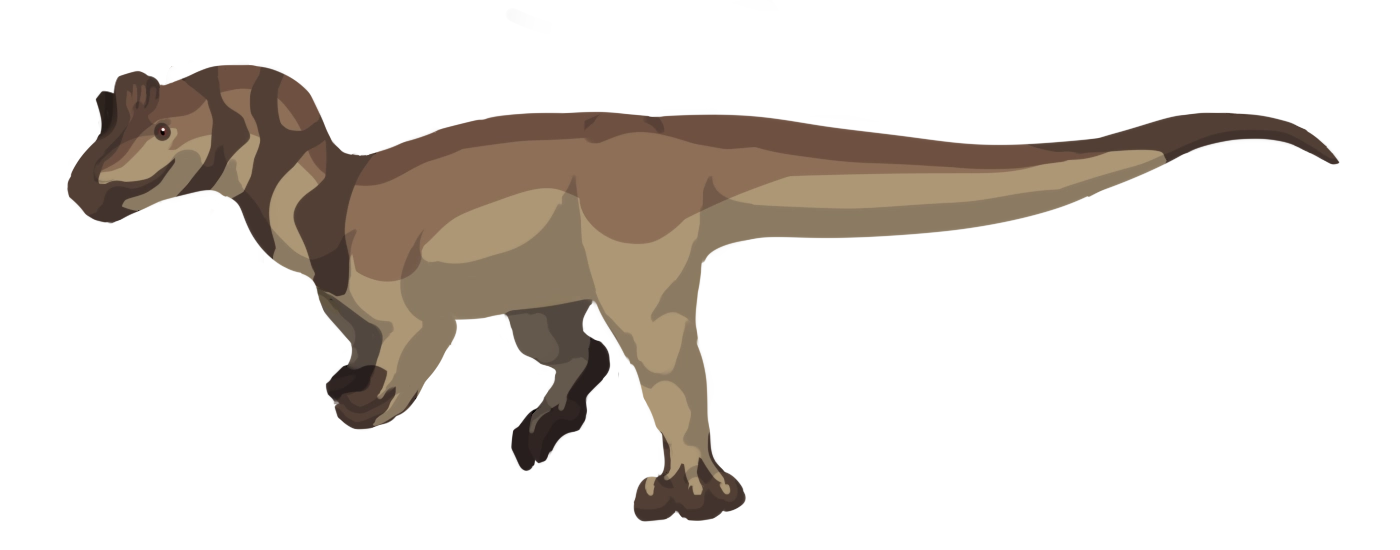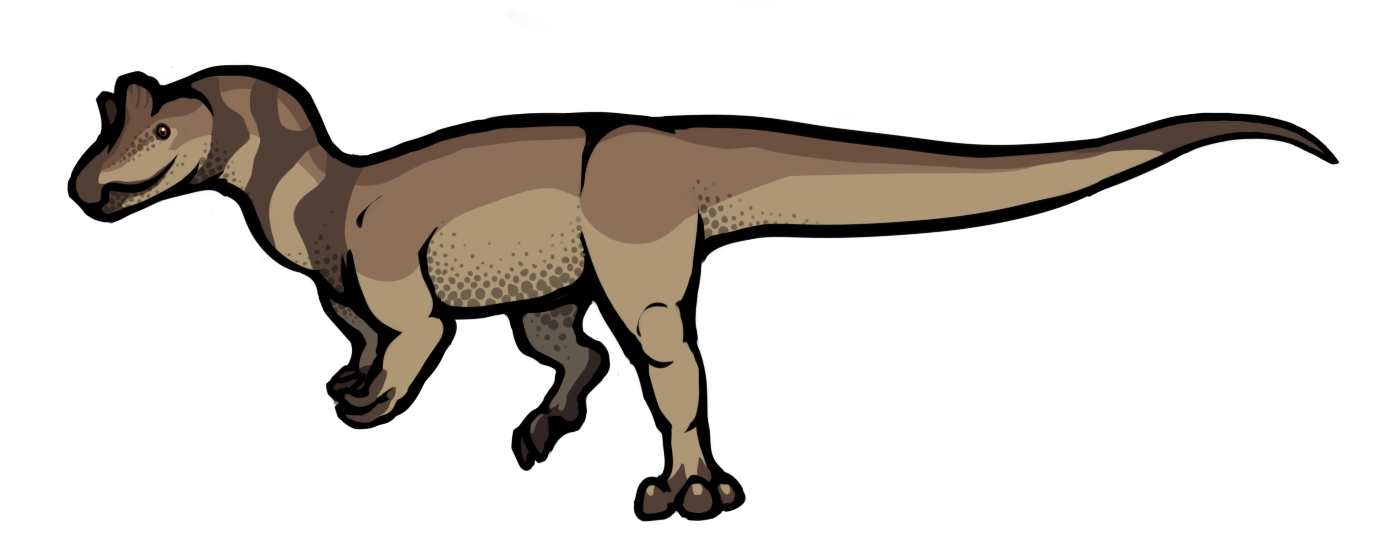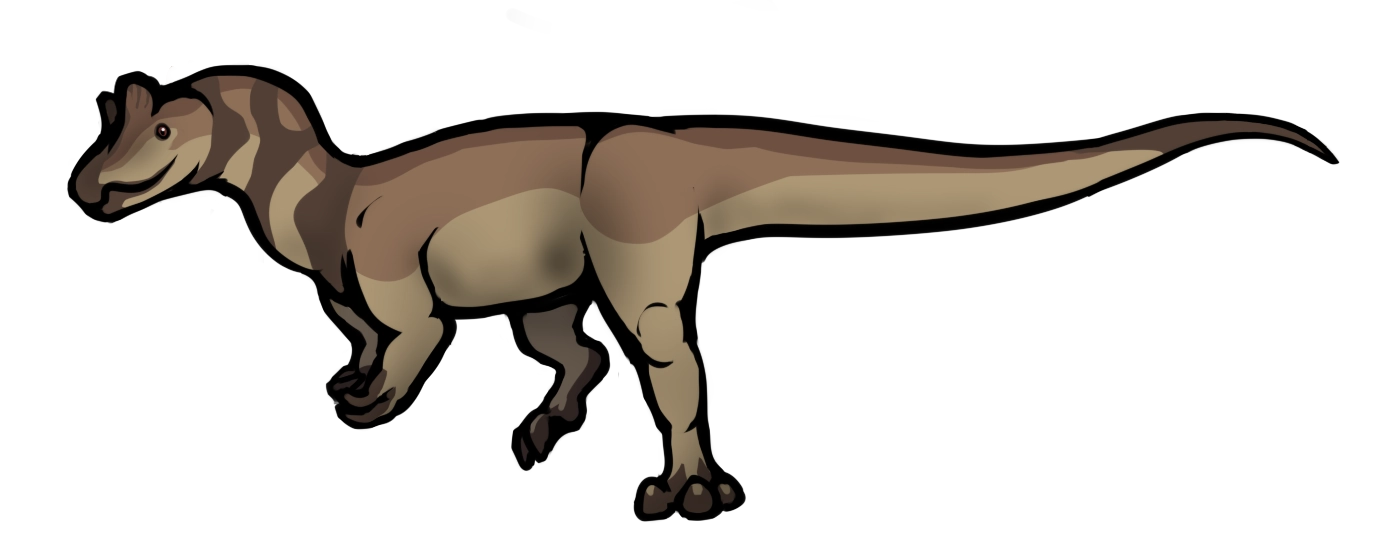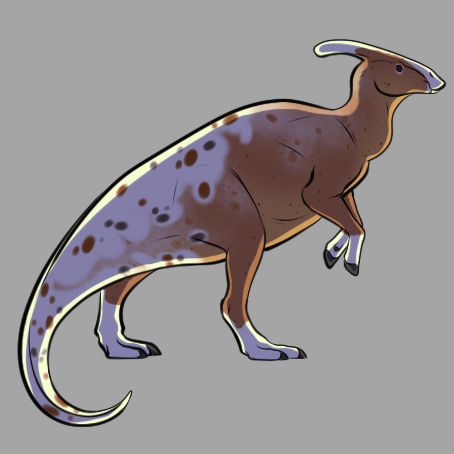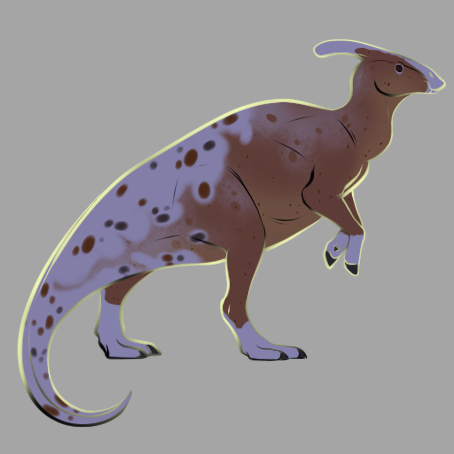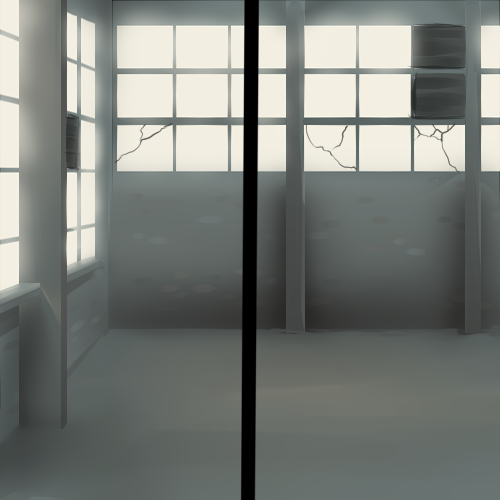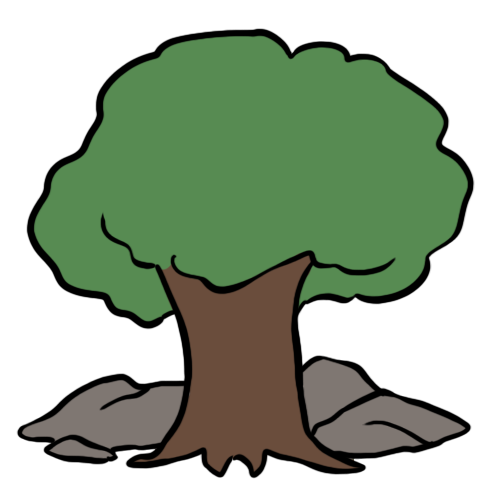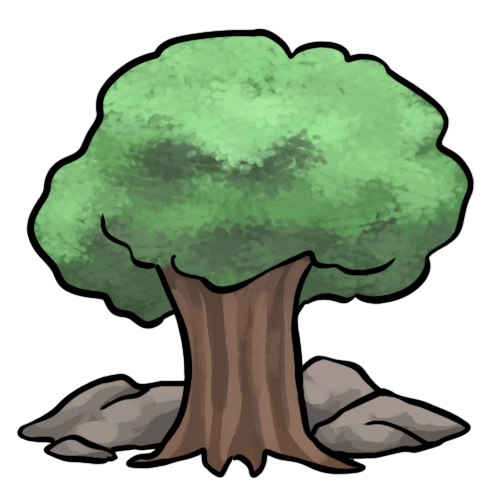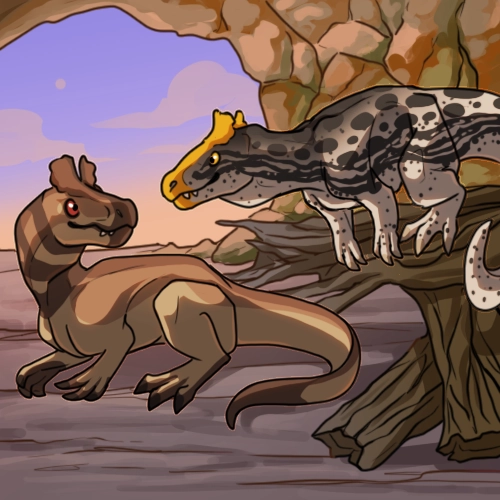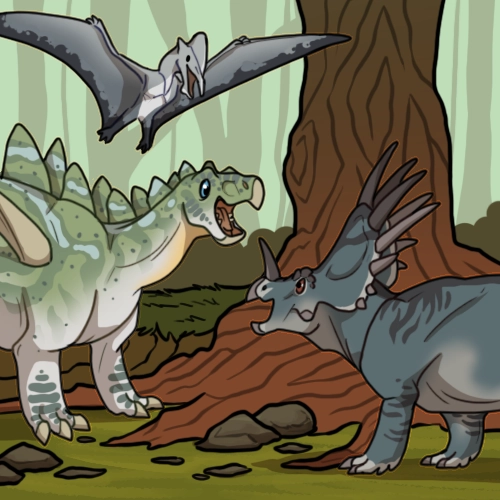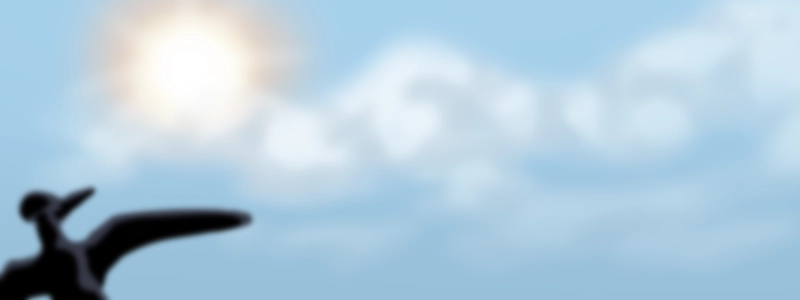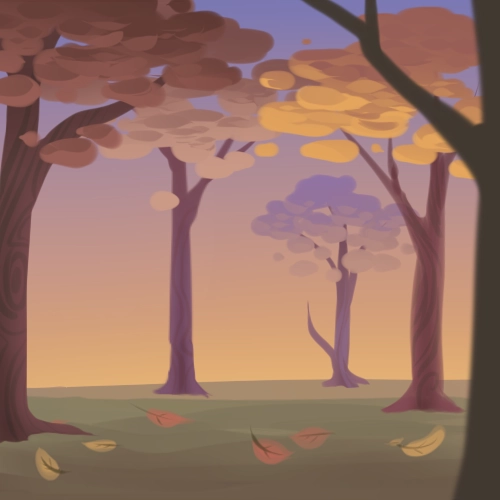This guide covers what is required in the composition of scenes for the following medias:
2D Artwork - Traditional and digital art.
3D Artwork - Any artwork that has been created in a 3D modelling program, such as Blender.
Handmade Crafts - Any artwork that has been created using handmade elements, such as clay, sculpture, sewing, paper crafts, etc.
Literature - Written works.
Skip to:
- Characters - Shading - Backgrounds - Elements - Literature -
Characters
Character appearance
Dinosaurs MUST match their imports. This applies to focus characters and extra background characters. However, they can have exaggerated anatomy, be stylized, and have custom body shapes. This means that:
- Stylizing your characters should not create new features.
-- For example, an overweight dino with a dewlap mimicking Flair, or feathers styled to look like manes, crests or hair. - Anatomy important to the species must be present; such as body proportions, snout length, decorative features, number of fingers and toes, etc.
-- For example, a Cryo cannot be drawn without a crest, Suchos must have long snouts, Utahs require their sickle claws. - Features not present on the import, such as feather crests, spikes, quills, etc. are not allowed for official artwork.
- Markings should be accurate to the import, but can be simplified as long as they are roughly in the right area and recognisable.
- Scars and accessories must be present unless there is a reason for them to be missing. This can be due to the dinosaur being younger and not having acquired them yet, or addtionally in the case of accessories, an interaction causing the item to be removed.
Further examples can be found on the Quality Standards page.
Character age
Your dinosaur can be depicted as any age for most quests and event prompts. The only exceptions are:
- Aging Quests - The characters being aged must be depicted as each growth stage once with no duplicates. These quests can be submitted in any order as long as a note is added to say what growth stage the submission is for. Background characters that are not being grown can be freely depicted as any age.
- Courtships - Both dinosaurs must be depicted as adults.
Characters are allowed to "grow into" their markings, as long as the import is still recognizable. They can also present slightly different markings colours or shapes when at young ages, similar to real life animals. Similarly, young dinosaurs with scars and accessories can be depicted without them if they acquire them later in life.
Visibility
Most quests will require either 50% or 75% of the focus dinosaurs to be visible to be passable. These percentages are roughly based on what sections of a character are visible in the image. You can view those sections here!
- 50% = 3.5 sections
- 75% = 5 sections
Additionally, when calculating the visibility we also consider the following:
- Tail tips, hands, feet, or small parts of the body being obscured are fine as long as the majority of the section is visible.
- Characters covered by their own body, such as when drawn from a front perspective, does not reduce what is counted as visible.
- Characters covered by other characters or background elements does reduce what is counted towards their visibility.
Some prompts, such as Strangers In These Here Woods, may require an extra dinosaur! If the dinosaur filling this role is simply a non-focus character being featured, then they do not have a minimum visibility requirement, unless one is specified by the prompt. In these cases, they just need to be recognisable enough to be considered visible. Otherwise, if they are acting as the extra dino while also receiving a roll themselves, they need to meet the visibility required of focus characters for that prompt. Silhouettes or cast shadows of dinosaurs do not fulfill the requirement of a required dinosaur.
3D and handmade models
Character models that you did not create yourself such as 3D models, toys and figurines, cannot be used in submissions, nor for EXP; unless significantly modified by you such as remodeling or scultping over part of the body. Adding small features such as horns or crests to a model is not considered a significant enough change.
Each character should have a unique model; one model can not be repainted as multiple characters. Models that are not poseable cannot be used for multiple submissions as models are required to be uniquely posed if used for more than one submission. Changing the angle the model is viewed from, without reposing the model, does not count as changing the pose.
Shading
Entries that require character shading must follow the contours of the character to create some sense of form or depth that helps defines the shape of the body and anatomy. Shading does not need to be highly detailed or complex but cannot be a simple gradient across the body. As long as these requirements are met, shading can present in a variety of styles. Below are a few examples, all of which can be clicked for a full-size view.
Lighting is not a substitution to shading
UNLESS the presence of lighting implies shadows and defines the form. In this case, it can be considered a reversed form of shading. “Halo” or "rim" lighting alone might not always count towards the shading requirements, especially if they only present minimally on the outline of the body.
For characters with dark bases or markings, form-defining lighting can be useful to make the character appear shaded! You are also allowed to lighten or otherwise adjust import colors to help make shading more distinguishable, as long as the character is still recognizable.
Incorrect Examples
Backgrounds
Every submission, regardless of whether it's in a set or standalone, must have a unique background. Backgrounds can be in similar settings, have similar elements, and similar framing, but should not be split pieces of one larger background. This also includes panels that share a background with slight edits to it, such as time of day or season - these will also not count.
Background and scene elements
Elements can be almost anything in a scene; except for the basic foundations, such as the ground and the sky. Anything on top of these foundations is what's separated into elements, as long as they have some level of detail or rendering. Rendering can be achieved through lineart detailing, shading and textures. These different techniques can be combined together. For example, shading that is too minimal by itself can have some additional minimal lineart or texture detail added to create a rendered element that is acceptable.
You do not have to show the sky or the ground, nor render them, since they are not counted as elements on their own.
- For interior scenes, a basic wall will take the place of the "sky" and will not count as an element, however added hallways, or things on the wall can count. Flooring will take the place of the "ground", but added things on the ground can count as elements.
- For underwater scenes, the base "water" will take the place of the "sky" and will not count as an element. In partially underwater scenes where the sky is visible, the base water will instead take the place of the “ground”, unless the ground is also visible.
Background elements must be clear enough to distinguish, unobscured and the majority of it should be visible in the scene. Elements that are heavily cropped out of the scene, covered by other things, too blurry, or otherwise indistinguishable, will not count towards the minimum. Elements that are split between panels, such as in comics, do not count towards the element total. Items that are too small or vague to be given detail cannot be counted as an element on its own. However, they can be grouped together as an element.
The following do not count as elements:
- Focus characters
-- Characters that are not the focus can count as a single “added character” element - Particle effects - snow, dust, rain, stars, etc.
-- Individual snowflakes, or detailed rain drops, etc. can count - Light rays
- Simple or copy-pasted drop/cast shadows
-- Detailed hand-drawn shadows can count - Flat color clouds, sun, moon
-- Rendered clouds, or sun/moon with more detail outside of flat color can count - Simple textures - grass texture, rock texture, etc.
- Stamped/brushed elements such as leaf brushes, tree brushes, etc.
-- If rendered on top of, or otherwise transformed, they can be counted
Photographs cannot be used in place of backgrounds, regardless of medium
Minor photobashing is allowed but you should not rely heavily on them for all of your detail.
- You must credit and link back to all of the photos you use.
- All photos used must either be taken by yourself, free-use or otherwise licensed.
- Photos incorporated into your artwork must be significantly edited, to the point where it does not look like a photograph.
- Photos pasted onto the background with minimal edits (such as blurring, cropping, or adjusting the colors) will not be accepted.
Examples of passable backgrounds

This background has three elements; the windows, foliage and beams in the wall. The walls take the place of the sky in an interior and wouldn't count as an element alone. The bricks and cracks count as texturing, not elements by themselves.
3D backgrounds and hand-crafted scenes follow the same element rules as 2D backgrounds
Craft photographs and renders should have all elements clearly visible and in-focus. Scenes and environments must have detail and variation in elements; environments composed entirely of 1-2 items will not be passable. You may not re-use the same scene or environment for multiple submissions.
Images should also be composed so that no placeholder elements, edges of planes, corners of scenes, tables, etc. are visible. For example, when taking a photo of a handmade scene, the table that the scene is sitting on should not be visible in the frame. The exception to this is pictures and renders that are not meant as scenes - such as a picture of a crocheted character that is not being used as a quest image.
- You may use pre-made assets to create scenes and environments, but you must credit the ones you use.
- Scene assets must be made up of your own creations; they can be made out of any material but must be crafted by you.
Literature
Word count and story focus
Literature entries must meet the required word count, which can be found in each prompt's description. Author’s notes, titles, headers, and any other non-story related text do not count towards the minimum word count.
70% of the minimum word count should be dedicated to activities related to the prompt. For example, a prompt with a minimum word count of 1000 words will need to be on topic for at least 700 words.
- On topic does not have to be the literal act of the prompt, and can include activities leading into and after the prompt occurs
- For example, for a hunting prompt, characters tracking prey, hunting it, and then bringing it back & eating it would all be considered “on topic”.
-- However, a description of the characters going off to visit the beach would be considered off-topic, unless the beach is related to their hunt.
Character focus
Focus characters should be mentioned by name and described somewhere in the story. Extra non-focus characters do not need to be mentioned by name, but must be described clearly enough to identify them, and must be linked in the submission.
Additionally, simply “name-dropping” a character in a story will not count as a feature, either for quest credit or EXP. Featured characters and cameos must participate in the story somehow to count for credit - this participation does not need to be all throughout the story, but should be more than a single description or single interaction.
Incorrect examples of focus for prompts and characters
Here's an example of literature where the story does not follow the Urban Explorer prompt because of how vague it is; we don't get to see how the dinosaur interacts with the urban environment. This piece is also too repetitive and filler-like. This would not pass for a quest but could still be eligible for EXP.
Bacon Bits loved urban exploring. He explored the urban areas he loved exploring. There were a lot of buildings; there was an abandoned pet shop, an abandoned grocery store, an abandoned car shop, an abandoned bicycle shop, an abandoned fast food place, an abandoned gas station, an abandoned drink stand, an abandoned electronics store. A lot of places he had never seen before! Bacon bits grew up underground in the alpha labs and never got to urban explore before, but now he can! He really enjoys going to all the different buildings and exploring them. Bacon Bits is a tan colored Albertosaurus with stripes of red across his body, like a piece of bacon! He also has quills. Before escaping the Alpha Labs he had never explored an urban area, so this is his first time exploring it! He really loves it and enjoys seeing all the abandoned buildings. It's nothing like when he lived underground in the labs, there were no abandoned buildings down there. But now he gets to explore! It's something he's come to really love since it's not anything like where he grew up.
Here's an example of literature where several characters are mentioned briefly or name-dropped. Only Mako is featured enough to be a focus character. None of the extra characters are present enough to be focus characters or receive EXP from this piece. They also don't feature enough to count as bonus EXP for Mako; in this example it would be the Starter bonus but this also applies to the Personal and Other Member's Dinosaur bonuses.
Mako lazily soared above the isles, his feathers beginning to warm in the morning sun. Fatigue still clung to his eyes as he veered towards the coast, hoping to get a quick breakfast in before the rest of the flock woke up. Being a literal early bird made mornings peaceful, albeit lonley, and he rarely took his meals with company. This morning was no different. He swooped down closer to the water, hovering just above the surface to better see any movement below. The silvery ripples beneath him made the job difficult, but he trusted his keen senses to do the rest. A slight movement caught his eye and instinct took over. He snapped his jaws down into the water. A familiar briny taste filled his senses and he hungrily gobbled down the fish he snatched. With a whetted appetite, he continued along the coast in search of more.
Focused as he was on his task, he didn’t notice he had company until shadows filled his vision. Looking up, Mako was greeted with the sight of several flock-mates soaring near. Daybreak, despite her name, did not enjoy the mornings and she hovered close to Mako. Shiloh and Inkblotch were not far behind, their eyes squinting in the salty air. Mako’s lonely morning was not so lonely anymore, and while he enjoyed the peace, he enjoyed the company of his family even more. Together the four of them continued the hunt, chatting and fishing, awaiting what the rest of the day might bring.
Roleplays can be submitted as literature entries
Roleplays can be considered collaborative literature submissions, as long as they are readable and otherwise meet all the Quest Requirements and Quality Standards. Each person's part does not need to be marked in the roleplay, but each person involved should be credited or sourced.






